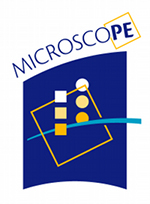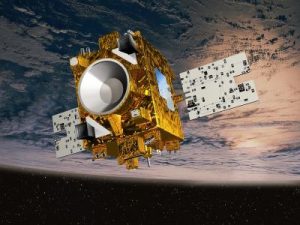Microscope
In the CNRS Newspaper
- The principle of equivalence is still valid! (December 4th 2017)
- The equivalence principle in testing (April 25th 2016)
In the news
- First results from the MICROSCOPE satellite confirm Albert Einstein’s theory with unparalleled accuracy (4th December 2017)
- News from the Microscope satellite (7 April 2017)
- The Microscope satellite begins its scientific tests (16 november 2016)
- Microscope switches to fine pointing mode and reaches full sensitivity (11 may 2016)
- Test mass release and reception of first data (2 may 2016)
- Launch of the Microscope satellite from the Kourou base (25 april 2016)
The scientific community of experimental gravitation
The MicroScope mission was initiated within the French experimental gravitation community, structured in 1995 in a GDR (Research Grouping) of the CNRS supported by CNES and ONERA.
During its 12 years of operation, the GDR GREX (Gravitation and Experiment) has organized numerous meetings and conferences bringing together the international community of researchers concerned and accompanying the birth of Virgo, as well as the emergence of the ACES/PHARAO and MicroScope projects.
Since 2010, a specific CNRS INSU/INP action entitled GRAM (Gravitation, References, Astronomy, Metrology) has been structuring the work of this community and continues to support and bring out new projects in experimental gravitation. In 2016, GRAM became a national program of the CNRS.
Gravitational interaction plays a predominant role in physics from the macroscopic to the universe scale. It is well described by the theory of general relativity, but important questions remain unanswered. At the end of the 20th century, experimental studies were developed to answer these questions and to test the theory of general relativity.
![]() An essential prediction of general relativity is the existence of gravitational waves. Direct observation of gravitational radiation was the goal of the large Virgo and Ligo interferometers, which announced the first direct detections of gravitational waves.
An essential prediction of general relativity is the existence of gravitational waves. Direct observation of gravitational radiation was the goal of the large Virgo and Ligo interferometers, which announced the first direct detections of gravitational waves.
![]() All attempts at theoretical unification between general relativity and quantum physics lead to changes in the theory. These often introduce apparent violations of the principle of equivalence which is the basis of the theory of general relativity. These violations could manifest themselves in experimental tests at a higher degree of precision than is currently demonstrated. The main objective of the MicroScope project is to test this principle to a degree of precision about 100 times better than what exists today.
All attempts at theoretical unification between general relativity and quantum physics lead to changes in the theory. These often introduce apparent violations of the principle of equivalence which is the basis of the theory of general relativity. These violations could manifest themselves in experimental tests at a higher degree of precision than is currently demonstrated. The main objective of the MicroScope project is to test this principle to a degree of precision about 100 times better than what exists today.
![]() Space techniques offer new experiments to verify the laws of gravitation with the highest precision. This is true for projects to detect gravitational waves and to test the principle of equivalence, as well as for projects to test general relativity, such as the ACES/Pharao project which aims to put a cold atom clock in the International Space Station in order to accurately test the law of redshift.
Space techniques offer new experiments to verify the laws of gravitation with the highest precision. This is true for projects to detect gravitational waves and to test the principle of equivalence, as well as for projects to test general relativity, such as the ACES/Pharao project which aims to put a cold atom clock in the International Space Station in order to accurately test the law of redshift.
These various projects constitute discriminant tests of general relativity. Since general relativity is a fundamental theory without any free parameters, a possible deviation would have a considerable impact especially in astrophysics and cosmology. On the other hand, any confirmation with a better degree of precision reinforces one of the pillars of fundamental physics. All these experiments, which have the common characteristic of seeking to measure small effects, make use of the most advanced technologies. Theory also plays an important and unifying role through the exploitation of the results, the interpretation of their significance and their relationship to theory, or noise control methods.
The MicroScope project
The MicroScope project was proposed, led by the ONERA Department of Physical Measurements (DMPH), the CNES and Cerga (now GeoAzur, a joint laboratory of the CNRS, the Côte d’Azur Observatory/OCA and the University of Nice Sophia Antipolis) with European partners (University of Bremen, DLR, PTB, ESA). The CNES is in charge of the project management.
The Microscope mission has been accompanied by numerous works and scientific publications concerning especially the following issues.
![]() What is the interest of a MicroScope-type space mission to test the principle of equivalence?
What is the interest of a MicroScope-type space mission to test the principle of equivalence?
In several theoretical schemes aimed at generalizing the standard model, the possibility of the existence of a new interaction appears, in addition to the four already known. This idea leads to new neutral gauge bosons that can manifest themselves according to the values of their masses in particle physics or by the existence of new long-range forces.
A new long-range force could result from the exchange of neutral zero spin particles and extremely low masses, the existence of which is suggested by unification models. Whatever its origin, such a force could, by superimposing itself on gravitation, manifest itself in apparent violations of the principle of equivalence.
This principle, already very well tested in experiments carried out on Earth, will see its accuracy greatly improved by the MicroScope experiment through the comparison of several pairs of accelerometers embedded in a drag-compensated satellite.
![]() Are electrostatic accelerometers of the type developed by Onera capable of performing this test to the desired accuracy?
Are electrostatic accelerometers of the type developed by Onera capable of performing this test to the desired accuracy?
Ultrasensitive accelerometry has long been a strategic research focus for Onera, and the performance of this instrumentation has been validated by laboratory experiments and other space missions in the field of measuring the Earth’s gravity field (in particular CHAMP, GRACE and GOCE).
The evaluation of sensitivity limits for future fundamental physics missions motivated specific theoretical and experimental investigations that confirmed the feasibility of the MicroScope experiment.
![]() What should be the masses characteristics?
What should be the masses characteristics?
Much work has also been done on the relationship between the equivalence principle test and the Standard Model of Particle Physics. In particular, it has been necessary to make the most appropriate choices for the pairs of materials to be tested, so as to optimise the chances of identifying a violation of the equivalence principle if it exists, and then to specify as precisely as possible the characteristics of the additional force that would be responsible for it.
![]() What should be the characteristics of the mission?
What should be the characteristics of the mission?
n order to take full advantage of the benefits of doing this experiment in space, many studies have been carried out on the choice of orbit, the satellite’s pointing mode and the correction of many sources of disturbance. For example, the objective of reducing the effects of the gravity gradient led to the choice of a circular orbit.
The Science Working Group
The Science Working Group supervises and coordinates data analysis. It is interdisciplinary and international.
The Science Working Group It also acts to maximize the spectrum of use of mission data. In particular, calls for ideas coupled with international workshops have been organised in previous years and others are planned for the future.
Microscope data will thus be analysed not only for the test of the equivalence principle, the main objective of the mission, but also for other purposes in physics and earth science, especially for a better understanding of the Earth’s gravity field and disturbances in the orbiting environment.


